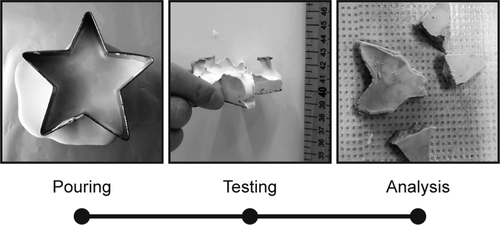当前位置:
X-MOL 学术
›
J. Chem. Educ.
›
论文详情
Our official English website, www.x-mol.net, welcomes your
feedback! (Note: you will need to create a separate account there.)
Introducing Engineering Design and Materials Science at an Earlier Age through Ceramic Cold Casting.
Journal of Chemical Education ( IF 2.5 ) Pub Date : 2018-11-27 , DOI: 10.1021/acs.jchemed.8b00404 Alexander J Boys 1 , Mark C Walsh 2
Journal of Chemical Education ( IF 2.5 ) Pub Date : 2018-11-27 , DOI: 10.1021/acs.jchemed.8b00404 Alexander J Boys 1 , Mark C Walsh 2
Affiliation

|
Elementary and middle school science curriculums typically focus on generating an interest in science and engineering through the use of hands-on activities that demonstrate specific concepts. Laboratory activities designed in this manner often circumvent some of the main challenges that engineers and scientists face, namely balancing advantages and disadvantages for a variety of potential solutions to solve a specific problem. This activity was designed to show students that different solutions for a given problem can exist, and engineers must manage priorities when choosing the best solution. This laboratory involves cold casting ceramics slurries with varying viscosities into a mold. The resulting casts have a varying final density, controlled by the initial viscosity. Students are presented with different outcome measures regarding the objects they cast: ease of manufacturing, cost, aesthetics, and mechanical properties. Based on the laboratory design, no single cast will perform the best in any of these categories. The students are then asked to choose the best mold, and justify their answers based on the initial problem presented to them by balancing which outcome measures they consider to be important for solving this specific problem. This laboratory teaches basic science concepts like viscosity and density, while addressing common industrial manufacturing issues, such as cost and ease of manufacturing. Through a combination of these features, this laboratory introduces engineering and design concepts using the scientific method to students at an earlier age.
中文翻译:

通过陶瓷冷铸在更早的时期引入工程设计和材料科学。
小学和中学科学课程通常着重于通过演示特定概念的动手活动引起对科学和工程学的兴趣。以这种方式设计的实验室活动通常会规避工程师和科学家面临的一些主要挑战,即平衡各种解决特定问题的潜在解决方案的优缺点。该活动旨在向学生展示针对给定问题的不同解决方案可以存在,工程师在选择最佳解决方案时必须管理优先级。该实验室涉及将具有不同粘度的陶瓷浆料冷铸到模具中。所得铸件具有受初始粘度控制的变化的最终密度。向学生展示有关他们所投对象的不同成果衡量标准:制造的简易性,成本,美观性和机械性能。根据实验室的设计,在这些类别中,没有任何一个铸件表现最佳。然后,要求学生选择最佳的模子,并通过平衡他们认为对解决这个特定问题很重要的结果度量来根据提出的最初问题来证明自己的答案是正确的。该实验室教授基础科学概念,例如粘度和密度,同时解决常见的工业制造问题,例如成本和制造难度。通过这些功能的结合,该实验室采用科学的方法向年龄较小的学生介绍了工程和设计概念。美学和机械性能。根据实验室的设计,在这些类别中,没有任何一个铸件表现最佳。然后,要求学生选择最佳的模子,并通过平衡他们认为对解决这个特定问题很重要的结果度量来根据提出的最初问题来证明自己的答案是正确的。该实验室教授基础科学概念,例如粘度和密度,同时解决常见的工业制造问题,例如成本和制造难度。通过这些功能的结合,该实验室采用科学的方法向年龄较小的学生介绍了工程和设计概念。美学和机械性能。根据实验室的设计,在这些类别中,没有任何一个铸件表现最佳。然后,要求学生选择最佳的模子,并通过平衡他们认为对解决该特定问题很重要的结果度量来根据所面临的最初问题来证明自己的答案是正确的。该实验室教授基础科学概念,例如粘度和密度,同时解决常见的工业制造问题,例如成本和制造难度。通过这些功能的结合,该实验室采用科学的方法向年龄较小的学生介绍了工程和设计概念。然后,要求学生选择最佳的模子,并通过平衡他们认为对解决这个特定问题很重要的结果度量来根据提出的最初问题来证明自己的答案是正确的。该实验室教授基础科学概念,例如粘度和密度,同时解决常见的工业制造问题,例如成本和制造难度。通过这些功能的结合,该实验室采用科学的方法向年龄较小的学生介绍了工程和设计概念。然后,要求学生选择最佳的模子,并通过平衡他们认为对解决这个特定问题很重要的结果度量来根据提出的最初问题来证明自己的答案是正确的。该实验室教授基础科学概念,例如粘度和密度,同时解决常见的工业制造问题,例如成本和制造难度。通过这些功能的结合,该实验室采用科学的方法向年龄较小的学生介绍了工程和设计概念。同时解决常见的工业制造问题,例如成本和制造便利性。通过这些功能的结合,该实验室采用科学的方法向年龄较小的学生介绍了工程和设计概念。同时解决常见的工业制造问题,例如成本和制造便利性。通过这些功能的结合,该实验室采用科学的方法向年龄较小的学生介绍了工程和设计概念。
更新日期:2018-11-27
中文翻译:

通过陶瓷冷铸在更早的时期引入工程设计和材料科学。
小学和中学科学课程通常着重于通过演示特定概念的动手活动引起对科学和工程学的兴趣。以这种方式设计的实验室活动通常会规避工程师和科学家面临的一些主要挑战,即平衡各种解决特定问题的潜在解决方案的优缺点。该活动旨在向学生展示针对给定问题的不同解决方案可以存在,工程师在选择最佳解决方案时必须管理优先级。该实验室涉及将具有不同粘度的陶瓷浆料冷铸到模具中。所得铸件具有受初始粘度控制的变化的最终密度。向学生展示有关他们所投对象的不同成果衡量标准:制造的简易性,成本,美观性和机械性能。根据实验室的设计,在这些类别中,没有任何一个铸件表现最佳。然后,要求学生选择最佳的模子,并通过平衡他们认为对解决这个特定问题很重要的结果度量来根据提出的最初问题来证明自己的答案是正确的。该实验室教授基础科学概念,例如粘度和密度,同时解决常见的工业制造问题,例如成本和制造难度。通过这些功能的结合,该实验室采用科学的方法向年龄较小的学生介绍了工程和设计概念。美学和机械性能。根据实验室的设计,在这些类别中,没有任何一个铸件表现最佳。然后,要求学生选择最佳的模子,并通过平衡他们认为对解决这个特定问题很重要的结果度量来根据提出的最初问题来证明自己的答案是正确的。该实验室教授基础科学概念,例如粘度和密度,同时解决常见的工业制造问题,例如成本和制造难度。通过这些功能的结合,该实验室采用科学的方法向年龄较小的学生介绍了工程和设计概念。美学和机械性能。根据实验室的设计,在这些类别中,没有任何一个铸件表现最佳。然后,要求学生选择最佳的模子,并通过平衡他们认为对解决该特定问题很重要的结果度量来根据所面临的最初问题来证明自己的答案是正确的。该实验室教授基础科学概念,例如粘度和密度,同时解决常见的工业制造问题,例如成本和制造难度。通过这些功能的结合,该实验室采用科学的方法向年龄较小的学生介绍了工程和设计概念。然后,要求学生选择最佳的模子,并通过平衡他们认为对解决这个特定问题很重要的结果度量来根据提出的最初问题来证明自己的答案是正确的。该实验室教授基础科学概念,例如粘度和密度,同时解决常见的工业制造问题,例如成本和制造难度。通过这些功能的结合,该实验室采用科学的方法向年龄较小的学生介绍了工程和设计概念。然后,要求学生选择最佳的模子,并通过平衡他们认为对解决这个特定问题很重要的结果度量来根据提出的最初问题来证明自己的答案是正确的。该实验室教授基础科学概念,例如粘度和密度,同时解决常见的工业制造问题,例如成本和制造难度。通过这些功能的结合,该实验室采用科学的方法向年龄较小的学生介绍了工程和设计概念。同时解决常见的工业制造问题,例如成本和制造便利性。通过这些功能的结合,该实验室采用科学的方法向年龄较小的学生介绍了工程和设计概念。同时解决常见的工业制造问题,例如成本和制造便利性。通过这些功能的结合,该实验室采用科学的方法向年龄较小的学生介绍了工程和设计概念。







































 京公网安备 11010802027423号
京公网安备 11010802027423号